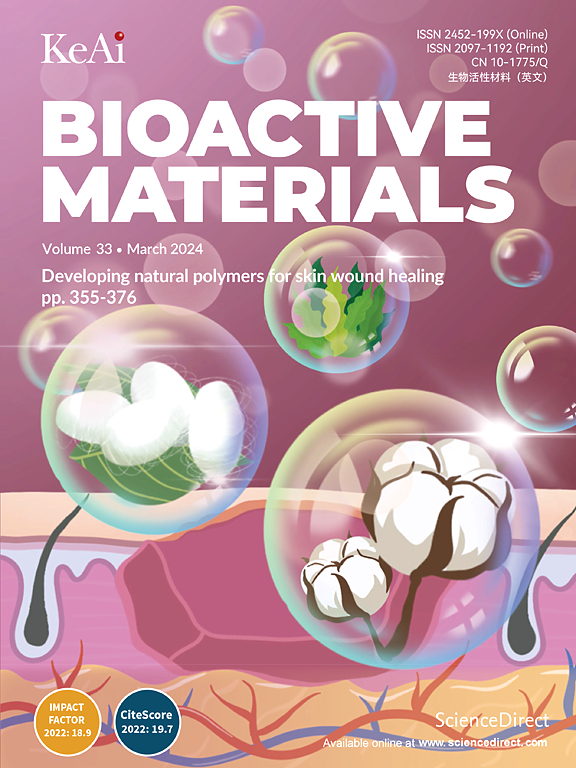DNA-mediated self-assembly oxidative damage amplifier combined with copper and MTH1 inhibitor for cancer therapy
IF 18
1区 医学
Q1 ENGINEERING, BIOMEDICAL
引用次数: 0
Abstract
Chemo-dynamic therapy (CDT) has a great potential in tumor extirpation. It entails producing hypertoxic reactive oxygen species (ROS) that damage the DNA of tumor cells and other biomacromolecules. However, the efficiency of CDT is severely hampered by the massive presence of glutathione (GSH) in tumor cells and the interference of ROS defense systems, such as Mutt homolog 1 (MTH1) protein sanitizes ROS-oxidized nucleotide pools. In this research, DNA-mediated self-assembly nanoparticles (HTCG@TA NPs) were engineered with high-performance amplified oxidative damage and gene therapy effect for synergistic anti-tumor treatment. Cu2+ was converted into Cu + by redox reactions to deplete GSH while H2O2 was catalyzed to generate hydroxyl radicals (·OH). As a result, the ROS level was evidently improved. Moreover, controllable-released TH588 prevented MTH1-mediated DNA repairing, thus aggravated oxidative damage to tumor cells. Meanwhile, the released functional nucleic acid G3139 downregulated the expression of Bcl-2, and accelerated the apoptosis of tumor cells. In conclusion, the HTCG@TA demonstrated significant effect in oxidative damage amplification and tumor inhibition both in vitro and in vivo, which has provided a new outlook for the clinical application of chemo-dynamic tumor treatment and synergistic gene therapy with self-delivery nanoplatforms.

dna介导的自组装氧化损伤放大器联合铜和MTH1抑制剂用于癌症治疗。
化学动力治疗(CDT)在肿瘤的清除中具有很大的潜力。它需要产生高毒性活性氧(ROS),破坏肿瘤细胞的DNA和其他生物大分子。然而,肿瘤细胞中大量谷胱甘肽(GSH)的存在和ROS防御系统的干扰严重阻碍了CDT的效率,如Mutt同源物1 (MTH1)蛋白对ROS氧化的核苷酸池进行消毒。在本研究中,dna介导的自组装纳米颗粒(HTCG@TA NPs)被设计成具有高性能的放大氧化损伤和基因治疗作用,用于协同抗肿瘤治疗。Cu2+通过氧化还原反应转化为Cu +消耗GSH, H2O2催化生成羟基自由基(·OH)。结果,ROS水平明显提高。此外,可控释放的TH588阻止了mth1介导的DNA修复,从而加重了肿瘤细胞的氧化损伤。同时释放的功能性核酸G3139下调Bcl-2的表达,加速肿瘤细胞凋亡。综上所述,HTCG@TA在体外和体内均表现出明显的氧化损伤放大和肿瘤抑制作用,为化学动力肿瘤治疗和自我递送纳米平台协同基因治疗的临床应用提供了新的前景。
本文章由计算机程序翻译,如有差异,请以英文原文为准。
求助全文
约1分钟内获得全文
求助全文
来源期刊

Bioactive Materials
Biochemistry, Genetics and Molecular Biology-Biotechnology
CiteScore
28.00
自引率
6.30%
发文量
436
审稿时长
20 days
期刊介绍:
Bioactive Materials is a peer-reviewed research publication that focuses on advancements in bioactive materials. The journal accepts research papers, reviews, and rapid communications in the field of next-generation biomaterials that interact with cells, tissues, and organs in various living organisms.
The primary goal of Bioactive Materials is to promote the science and engineering of biomaterials that exhibit adaptiveness to the biological environment. These materials are specifically designed to stimulate or direct appropriate cell and tissue responses or regulate interactions with microorganisms.
The journal covers a wide range of bioactive materials, including those that are engineered or designed in terms of their physical form (e.g. particulate, fiber), topology (e.g. porosity, surface roughness), or dimensions (ranging from macro to nano-scales). Contributions are sought from the following categories of bioactive materials:
Bioactive metals and alloys
Bioactive inorganics: ceramics, glasses, and carbon-based materials
Bioactive polymers and gels
Bioactive materials derived from natural sources
Bioactive composites
These materials find applications in human and veterinary medicine, such as implants, tissue engineering scaffolds, cell/drug/gene carriers, as well as imaging and sensing devices.
文献相关原料
公司名称
产品信息
阿拉丁
H2O2
阿拉丁
GSH
阿拉丁
H2O2
阿拉丁
GSH
Sigma
Tannin acid (TA)
 求助内容:
求助内容: 应助结果提醒方式:
应助结果提醒方式:


